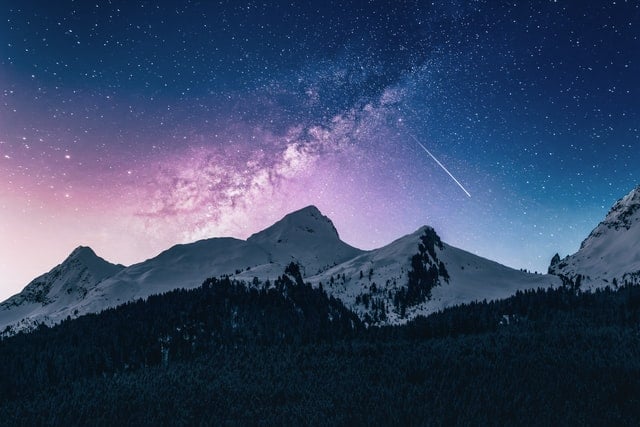The celestial or heavenly bodies in our universe have always been mysterious. While the ones that are outside our solar system are already mysterious as they are, even the ones within our solar system remain to be just as mysterious. One enigmatic planet, in this case, is Neptune, which is actually the final planet in our solar system and is actually quite a mystery regarding its surface. Speaking of its surface, does Neptune even have mountains of its own?
Even though Neptune is largely made out of gas, evidence points out to the possibility that it does have a mountain of its own. Of course, that mountain is made out of gas as well but it protrudes out of Neptune in such a way that it looks like a great dark spot when seen through the Hubble telescope.
While not technically a mountain in terms of what we usually describe as a mountain according to our common understanding, this gas mountain in Neptune is somewhat interesting because it allows us to know more about this mysterious and enigmatic planet. But, then again, let’s discuss more about the few things that we humans know about the last planet in our solar system.
What is Neptune made of?
Before we get to the point where we discuss about Neptune’s possibility of having a mountain, let us try to talk more about what this planet is made of so that we could understand why having a planet is somewhat weird and uncharacteristic for it.
Neptune is the eighth and farthest known planet from the Sun in our solar system if we don’t count the dwarf planet Pluto, which was previously counted as a planet but has since been kicked out due to some reasons. So, in case you didn’t know, the farther away a planet is from the Sun, the colder its temperatures will be because of how the Sun is the main source of heat or thermal energy in our solar system. That is why Mercury, the planet closest to the Sun is the hottest planet in the solar system, and Earth has just the right temperature for life to live in.
Known as a gas giant and is actually the fourth-largest planet in our solar system, Neptune is primarily made out of gas and said to have no solid surface. That means it might be impossible to really step on Neptune because of how it doesn’t have anything solid for you to step on. It is primarily made out of gas but astronomers say that it still has a point in its atmosphere that can be considered solid but such a point is still very much dynamic.
So, if planets are large chunks or rocks, how is Neptune even considered a planet if it doesn’t have a solid surface? Well, Neptune is still a rock of sorts because of how its core is made of a combination of rock and ice. However, everything surrounding its rocky core is not solid and is a combination of liquid and gas. Hence, the name “gas giant” or “ice giant”.
If we go by the numbers, Neptune is actually at least 80 percent icy materials that are made from a combination of water, methane, and ammonia. This allows Neptune to be quite dense as it ranks third in overall density in our solar system and has a mass that is 17 times that of Earth due to how dense this planet is. Neptune’s core alone is supposedly just as massive as Earth itself.
Meanwhile, Neptune’s atmosphere is said to be made up mostly of gases such as hydrogen, methane, and helium. These gases will eventually merge with the watery and icy portion of Neptune’s surface as they gradually reach close and closer to the core of the planet.
Because of how Neptune’s surface is so gassy, it is the windiest planet in the entire solar system and can have winds that are up to nine times stronger than the ones we experience on our own planet. This leads us to the point where we discuss more about the “mountains” on Neptune.
Are there any mountains on Neptune?
Now that we know what Neptune’s surface is like, you might wonder if this sort of a planet actually has mountains similar to the type of mountains we have on Earth. But, before that, let’s first talk a bit more about what a mountain is.
The Merriam-Webster dictionary defines a mountain as:
- A. a landmass that projects conspicuously above its surroundings and is higher than a hill
B. an elongated ridge
- A. a great mass
B. a vast number or quantity
So, going by those definitions and with what we understand about Neptune and its surface, can we go on to say that there is a possibility that this planet can have any mountains? Well, it is possible but not in the conventional sense of how we normally understand a mountain.
First off, because Neptune doesn’t have any solid surfaces, we probably cannot include it in the first dictionary definition of what a mountain is, which is a landmass that projects conspicuously above its surroundings and is higher than a hill. But what about the second definition?
Well, the second definition states that a mountain can be “a great mass”. That means that objects that are massive enough can be considered mountains. And when we say massive, we pertain to the mass of the object and not simply its shape, structure, or material. That means that, even if something isn’t solid, it can still be called a mountain as long as it has a great mass.
That said, it is possible for Neptune to have a mountain based on the second definition of the word even though it doesn’t have a solid surface and despite the fact that it is primarily made out of gas and liquid. If there is enough buildup of gas within any part of Neptune’s surface such that it is beyond the norm or that it stands out from the rest of the planet’s surface due to its large appearance and great mass, that buildup can be called a mountain. In fact, that is what the Great Dark Spot is.
The Great Dark Spot is a series of dark spots spotted by both Voyager 2 and the Hubble telescope on the surface of Neptune. These dark spots are, in fact, storms that happen from time to time and may only last for a few hours due to how volatile and active Neptune’s atmosphere is. That said, these dark spots are called “gas mountains” because of how massive the buildup of gas is on certain surfaces of the planet that they can actually be visible from outer space. In fact, the 1989 Great Dark Spot was large and massive enough to contain the entire planet Earth.
Going back, Neptune does indeed have mountains that are in the form of huge dark spots that are actually storms. These storms are not as permanent as the mountains we have on Earth and may disappear in as short as maybe two days. And what makes them “mountains” is that they are so huge and massive that some of them may even be as large as an entire planet itself.
Can we possibly live in Neptune?
Now that we know more about Neptune and what its surface and mountains are like, could it even be possible for us to live there or, at the very least, for us to visit the planet to know more about it?
Well, no. The short explanation is that Neptune is so cold due to its distance from the Sun. The average temperature on that planet is -200 degrees Celsius or -392 degrees Fahrenheit, which is too cold for humans or even life in general.
Meanwhile, we also have to consider the extremely intense winds there. Neptune’s winds are so strong that they are nine times stronger than the strongest winds we have experienced on Earth. If we struggle to live through the strongest typhoons our planet has ever seen, just imagine going through winds that are nine times stronger.
Of course, we also have to consider the fact that Neptune’s atmosphere is made up of gases that are normally too toxic for us. And even if we do get to use some sort of apparatus that will allow us to live through the gas in Neptune and even if we do build equipment that can withstand the extreme temperatures of that planet, we still have the winds to contend with. So, that basically means that Neptune is inhabitable for the likes of us.

